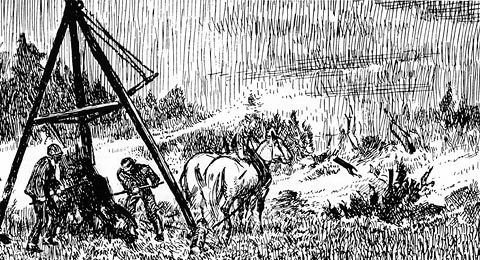| Fact & Fantasy: A History of Tavistock & District | Agriculture - Page 62 |
|
|
In the 1851 census of East Zorra we read of the log church on land donated by him, with a seating capacity of 100 and a value of $200. This church was replaced in 1866 by the present St. Matthews' Lutheran Church, and each generation since has donated land for the adjoining cemetery as the need arose. In 1864 a new residence was built of stone hauled by team and sleigh from North Easthope and corner-stones quarried at St. Marys. It is told that, as the structure mounted, a ramp was built up which the stone was hauled by wheelbarrow as the height of the new structure mounted. The elder son donned a breast collar and traces of a single horse to pull the barrow, while another man guided the vehicle up the incline. By such men were the pyramids raised! It is interesting to note that stone chips still come to the surface of the lawn where the mason spit and shaped them. In 1875 a new barn was built, framed out of hand hewn hardwood timbers, joined together with hickory pegs and set upon a solid stone foundation. These are a few hard facts in the life of the early settler. His first requisite was to provide food, clothing and shelter for his family, fodder for his livestock, horse-power for his harvesting, and equipment with which to carry it our. Any surplus, over home requirements was bartered for staple goods, at the Cassel or Tavistock stores, and the excess was returned in "due bills" or credit papers. Such surplus included wool, eggs, onions, lard, dressed poultry, butter, dried apples and cordwood. The pioneer of our sketch died in 1905,leaving a family of twelve. His farm was then taken over by his youngest son, who continued with the modernization and improvement. During his lifetime the house was renovated and the barn rebuilt, field layout was established and the tile drainage systems added. In 1967 while the present owner was adding to the system, two of the original inverted V-drains were unearthed at a depth of thirty inches, one of them, still carrying water from a spring to an outlet along a flowing stream. Modern methods of sound field-practice are following the principle of under drainage laid 100 years ago. Since 1944 this work was continued by a grandson. How long this "First Century" farm will survive into the Second, only time will tell. Until the beginning of World War I, the farmer could still lead the good life of self-sufficiency. In a very short time, in spite of resistance by established custom, a way of life disappeared. Mechanization, science and soaring land prices now dictated man's place in the sun. By present standards primitive tractors and machinery started to enter the picture and gradually farmers found they could make more money if they expanded their acreage and used machinery instead of labour. As a result farmers produced much more, sometimes too much. Prices weakened, and much was wasted. Smaller farmers could not compete and sold out. Larger farmers were caught in the same predicament and tried to produce more with less labour. A new procedure is good, only if it is soundly based. Thus the evolution of farming has turned the pioneer from his self-sufficiency into an individual whose operation is usually dependent on many other segments of industry and society. 
|
|
|
| PREVIOUS | TABLE OF CONTENTS | NEXT |